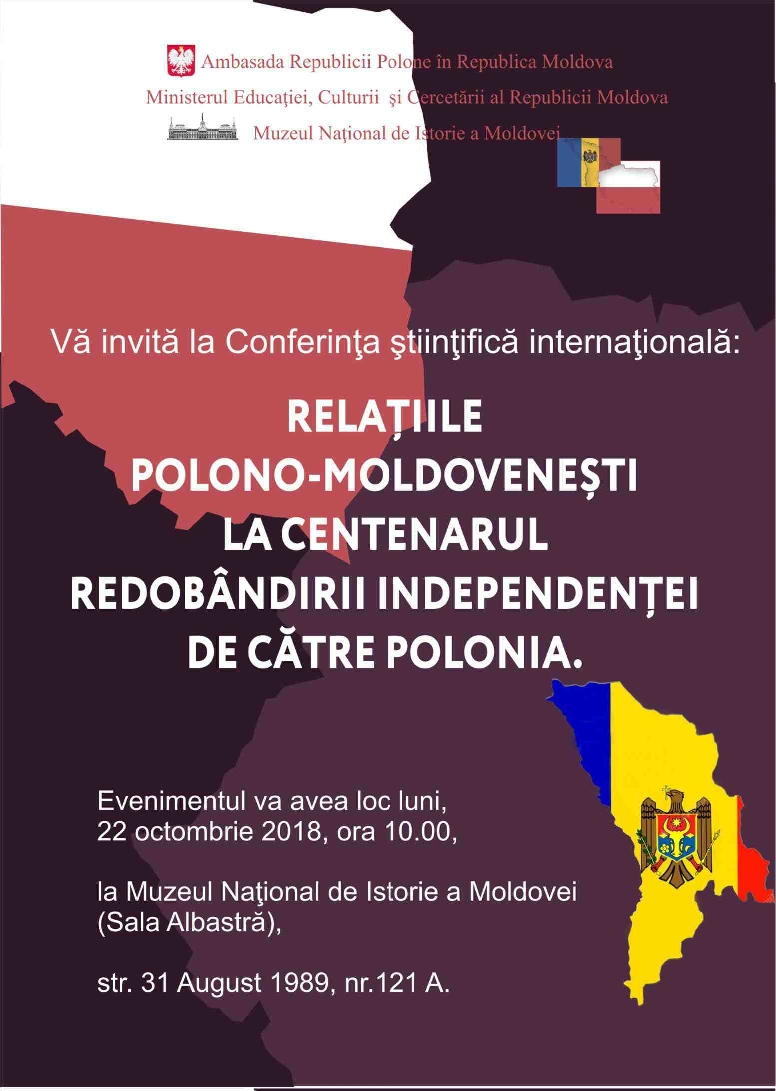  Events Archive Events Archive
International Scientific Conference “Polish-Moldovan relations to the centenary of the regaining of independence by Poland”
22 October 2018
The National Museum of History of Moldova hosted on Monday, October 22, 2018, starting at 10:00, the international scientific conference „Polish-Moldovan relations to the centenary of the regaining of independence by Poland".The conference was organised at the initiative of the Embassy of the Republic of Poland in Moldova, in collaboration with the National Museum of History of Moldova, the Ministry of Education, Culture and Research of the Republic of Moldova. The purpose of the conference was to analyze the content of Polish-Moldovan relations in their multilateral dimension. The reason for reflection is the 100th anniversary of the regaining of independence by Poland. The celebrated anniversary allows us to reflect on the influence exerted and to be exercised by the existence of the independent and modern Polish statehood on the Polish-Moldovan relations, on their ampitude, sphere and dynamics. It is also worth noting the role played by Poland and Poles in the political, social, cultural and economic transformations that take place in the lands of the former Principality of Moldova. The presence of Polish culture and language as well as the Polish-Moldovan collaboration in regional or continental aspect (Eastern Partnership, European integration, creation of international security structures) are also of great importance. More than 50 scholars and researchers from different scientific institutions from Moldova, Poland, Romania, Ukraine and Israel participated in the scientific event (National Museum of History of Moldova, State University of Moldova, State Pedagogical University of Moldova, Institute of Cultural Heritage, Institute of History, University of Warsaw, „Adam Mickiewicz" University of Poznań, Jagiellon University, University of Silesia, University of Bucharest, Catholic University of Lublin, Polish Institute of International Affairs, National Institute of Polish Cultural Heritage Abroad, "Maria Curie-Skłodowskia" University and representatives of the Polish community in Moldova (Polish organizations: Liga Polskich Kobiet, Polska Wiosna w Moldawii, Krakowianka etc.), journalists, politologists, writers, students, and so on. The event was moderated by Dr. Hab. Prof. Eugen Sava, Director of the National Museum of History of Moldova. Wlcoming messages are expected from E.S. Bartłomiej Zdaniuk, Ambassador Extraordinary and Plenipotentiary of the Republic of Poland to the Republic of Moldova; Monica Babuc, Minister of Education, Culture and Research of the Republic of Moldova; Acad. Gheorghe Duca, President of the Academy of Sciences of Moldova; Anton Coşa, the Roman Catholic Bishop of Chişinău. In the plenary session were presented 4 reports: Lilia Zabolotnaia (National Museum of History of Moldova, Chişinău, Republic of Moldova) - The Poles in Moldova; Svetlana Cebotari, Violeta Cotilevici (State University of Moldova, Department of International Relations, Political and Administrative Sciences, Chair of International Relations) - The Moldovan-Polish Relations in the Context of the New Geopolitical Metamorphoses; Kamil Całus (Ośrodek Studiów Wschodnich im. Marka Karpia w Warszawie) - Republika Mołdawii w polityce zagranicznej Rzeczpospolitej Polskiej / Bilateral relations between the Republic of Moldova and the Republic Poland: political and economic dimensions; Igor Caşu (State University of Moldova) - Poles as victims of the Communist Terror in MASSR and MSSR, 1924-40, 1940-41. The conference continued in four sections: Section 1 - Archeology. Middle Age and Modern History; Section 2 - Art. Culture. Church. Personalities; Section 3 - Modern History; Section 4 - Contemporary History. Political Section. The reports included studies on the history of the Poles in Moldova and the Moldovan-Polish secular relations (political, economic, cultural, military, dynastic), important personalities of Polish origin, activity of the Polish public organizations in Moldova, spiritual life, etc. The issue of contemporary Moldovan-Polish relations was addressed in particular in a geopolitical and international context. As part of the conference there was opened the exhibition „Polish-Moldovan relations to the centenary of the regaining of independence by Poland". The opening took place in the hall of the National Library between 11.00 and 12.00. ¶
|





 The side panels are elegantly decorated with refined cast-iron elements in the Art Nouveau style, displaying the brand name - "Ideal." The Polyglott model, featuring a bilingual keyboard patented in the United Kingdom by Max Klaczko from Riga, Latvia, was produced between 1902 and 1913, marking the first typewriter capable of writing in two languages. The "Ideal Polyglott" typewriter was actively sold in the Russian Empire and gained significant popularity in Poland, Bulgaria, and Serbia.
The side panels are elegantly decorated with refined cast-iron elements in the Art Nouveau style, displaying the brand name - "Ideal." The Polyglott model, featuring a bilingual keyboard patented in the United Kingdom by Max Klaczko from Riga, Latvia, was produced between 1902 and 1913, marking the first typewriter capable of writing in two languages. The "Ideal Polyglott" typewriter was actively sold in the Russian Empire and gained significant popularity in Poland, Bulgaria, and Serbia.













































